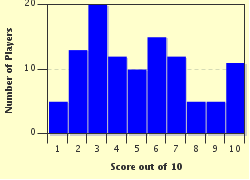Quiz Answer Key and Fun Facts
1. The factorial of an integer n is denoted by n!. This n! notation was first used by a French mathematician. Who was he?
2. Since n! = n x (n-1) x (n-2) x ... x 1, then n! can also be written as n(n-1)!. So, what is the value of (100!)/( 99!) ?
3. We know that n! = n(n-1)(n-2)...(1). For example, 4! = 4 x 3 x 2 x 1 = 24. But what does the double factorial of 4, namely 4!! represent?
4. Given that n! = n(n-1)(n-2)...(2)(1). Instead of multiplication, there exists an analog series that is defined by addition, that is, f(n) = n + (n-1) + (n-2) + ... + 2 + 1. This type of number is known as a/an?
5. A typical scientific calculator can calculate the value for the factorials up to 69!, but the value for 70! is greater than 10^100. Which of the following approximations is used to calculate the approximation for large factorials?
6. A positive integer that is in the form of n^{(n-1)^[(n-2)^...^{2^(1)}]} is called a/an ?
7. A prime number that is 1 more or 1 less than the value of a factorial is called a factorial prime. Which of the following numbers is not a factorial prime?
8. Factorial operations are used widely in combinations and permutations problems. To find the number of different ways one can select r items from a total of n items, we use the combination formula, which is n C r = (n!)/{[(n-r)!](r!)}. On the other hand, the formula for permutation, given by n P r, is?
9. Factorials also come in useful in calculus. Some exponential and trigonometry functions can be expressed as a power series of x, as what is stated and defined in which of the following theorems?
10. The factorial of 0, namely 0! is 0.
Source: Author
Matthew_07
This quiz was reviewed by FunTrivia editor
crisw before going online.
Any errors found in FunTrivia content are routinely corrected through our feedback system.

